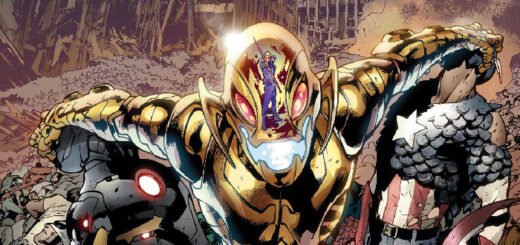Bob Ingersoll: The Law Is A Ass #387
THE AVENGERS GET STANDOFFISH
It’s getting so that in comics nowadays you can’t tell the good guys from the bad guys without a scorecard. And sometimes even then.
Maria Hill is currently the director of the Strategic Homeland Intervention, Enforcement and Logistics Division or S.H.I.E.L.D. for short – or SHIELD for even shorter and guess which route lazybones Bob is gonna take. So Maria should be one of the good guys, right? Then she came into possession of some fragments of a Cosmic Cube. A Cosmic Cube, when it was in full on cube form and not fragments, is a device that answers to the will of whomever possesses it and can be used to control matter and energy and even alter reality. So whomever holds the Cosmic Cube has to be careful with it, lest reality be warped in strange and dramatic ways. When the Cube is in fragment form, it’s just about as powerful but the holder has to be even more careful with it, because those fragments can go all Julia Child on you and cut the dickens out of your finger.
 Hill and SHIELD experimented on the Cube fragments, hoping to be able to use them to reshape reality as SHIELD deemed necessary. What they got was a little girl. The Cube fragments merged into a sentient being and did what newly-formed fictional A.I. that are confuse about their identity have been doing for years; it adopted the form of a little girl.
Hill and SHIELD experimented on the Cube fragments, hoping to be able to use them to reshape reality as SHIELD deemed necessary. What they got was a little girl. The Cube fragments merged into a sentient being and did what newly-formed fictional A.I. that are confuse about their identity have been doing for years; it adopted the form of a little girl.
Seriously, what is it about the symbology of little girl that screams confused and unsure of one’s self? I know a 63-year-old man who fits that descripti on pretty well, but you don’t see confused A.I. programs going all mid-life crisis.
on pretty well, but you don’t see confused A.I. programs going all mid-life crisis.
Anyway, the little girl called herself Kobik. Director Hill called her an asset. Hill had Kobik create Wayward Pines… err excuse me, Pleasant Hill, a quaint little town in backwoods Connecticut. It was 300 Kobiks by 50 Kobiks by 30 Kobiks, so was big enough to house a lots of people. Lots of carefully chosen people. 96 SHIELD operatives who oversaw a town populated by super villains.
Hill called them reformed super villains. But they weren’t reformed, they were transformed, because, Hill had Kobik change 58 super villains. Now those villains look and dress like ordinary people. Then Kobik wiped the minds of the super villains; gave them new memories and personalities. They lived like common people and did whatever common people did; except listen to Shatner covers. For all intents and purposes, these super villains were new people, decent people living the American dream in a small American dream town.
A town that was surrounded by a force field so that none of its residents could leave. It wasn’t a small town, it was prison that really looked a picture print by Currier and Ives. Guantanamo Bay in Norman Rockwell drag.
Which is pretty much the set-up of the current cross-over series Avengers: Standoff! that’s currently playing itself out in several books. Then, complications ensued. Several of the Avengers teams opposed what Director Hill was doing in Pleasant Hill which created conflict between SHIELD and the Avengers. But not as much conflict as when the super villains started to get their memories back. (Oops, did I forget the SPOILER WARNING? Not really. Didn’t think it was needed. Seriously, who didn’t see that revoltin’ development coming?)
So why does Bob I. the Lawyer Guy care about this? Because SHIELD is a governmental agency, meaning all those things found in the Bill of Rights apply to SHIELD and its brainwashing Bastille. I wondered is Maria Hill a good guy or a bad guy for creating this program. And is Pleasant Hill was even remotely constitutional.
Obviously, I’m talking primarily about the 8th Amendment. Even the NRA isn’t concerned about denying the right to bear arms to convicts who are actually serving prison terms. (The only way to stop a bad guy with a gun is with another bad guy with a gun just ain’t gonna cut it.) But how does the prohibition against cruel and unusual punishment affect this Attica of amnesia?
It’s unclear. There is no definitive definition of cruel and unusual punishment. The Supreme Court has ruled that courts should follow an “evolving standards of decency” test in determining whether a punishment is cruel and unusual. So the test changes as the standards of decency evolve throughout the world. Centuries ago being drawn and quartered was considered a just punishment. Most societies would no longer consider drawing and quartering to be humane. (And not just because the strain it puts on the horses would be cruelty to animals.)
Pleasant Hill utilizes mind alteration of some sort to keep it’s inmates under control. Such mind alteration would be a form of assault, as they constitute a physiological change to a person. In most jurisdictions assault is a crime and I’m pretty sure that standards of decency wouldn’t permit prisons to commit actual crimes on their inmates.
This isn’t a situation like a mentally ill patient who is given medical treatment to restore that person to mental health. This is taking people who are mentally healthy – criminals, but mentally healthy – and altering their brains so that they don’t behave like criminals anymore. This is an assault on the inmates’ cognitive liberty, which many courts are recognizing as being protected by the Bill of Rights.
The Supreme Court might rule Pleasant Hill unconstitutional because it violates standards of decency and inflicted cruel and unusual punishment. Or it might rule the mind wiping was cruel and unusual, because it a crime. As we don’t actually have a real-world counterpart to Pleasant Hill, I can’t definitively tell you how a real-world court would view Pleasant Hill.
I can tell you this, however, one of the tests frequently used is whether the punishment is unnecessarily severe. We know prisons in the Marvel Universe have power dampening apparatus, which can suppress the super powers of their inmates so super villains can be held in prisons without having their personalities wiped and replaced. That being the case, Pleasant Hill might have difficulty withstanding a legal challenge, because its practice of committing assaults on the mind is a more severe punishment than is necessary.
Another test that is pretty much universal in its application to a cruel and unusual punishment analysis is that prisons may not deprive inmates of the basic necessities of life. While Pleasant Hill does provide food, clothing, shelter, sanitation, and medical care, there is another necessity that Pleasant Hill omits; the inmate’s ability to have visits from family members.
The leading case on this matter is Overton v. Bazzzetta where inmates sued Michigan because of prison guidelines which limited who could visit inmates. The guidelines eliminated visitation rights for inmates who violated certain prison rules. It also denied inmates the right to have visits from their children if their parental rights had been terminated. The inmates sued under the First (free association), Eighth (cruel and unusual punishment), and Fourteenth (due process) Amendments. The Supreme Court upheld these regulations and found they bore a rational relation to the government’s interest in maintaining internal security in its prisons.
Overton only dealt with a partial denial of some of an inmate’s visitation rights. Inmates in Pleasant Hill are Cosmic Cubed into believing they’re different people. They’re not receiving family visits because they don’t know they have any families. And their families don’t know where they are.
Would the Overton analysis apply to the wide-spread and complete denial of all visitation rights by an inmate’s family and friends practiced in Pleasant Hill? How would the courts balance complete denial against the state’s need to maintain order? Especially when, as I noted before, Pleasant Hill’s mind wipe is a more severe form of punishment than is necessary for the purpose of imprisoning super villains.
I don’t know. The courts might rule in favor of the inmates and hold that denying them all visitation from family and friends in a manner that is more severe than it needs to be, is cruel and unusual punishment. Or they might not.
So why did I write this column, if I don’t know the answers to the questions I’m posing? Because these are the sort of things I think of when I read comic book stories. Even if there is no definitive answer, I still wonder what would happen if this happened in the real world.
And sometimes, like when I don’t have anything else to write about, I share what I’m wondering about with you. To see, are you pondering what I’m pondering?
(The first one of you who says anything about getting a monkey to use dental floss is gonna get such a hit!)

















